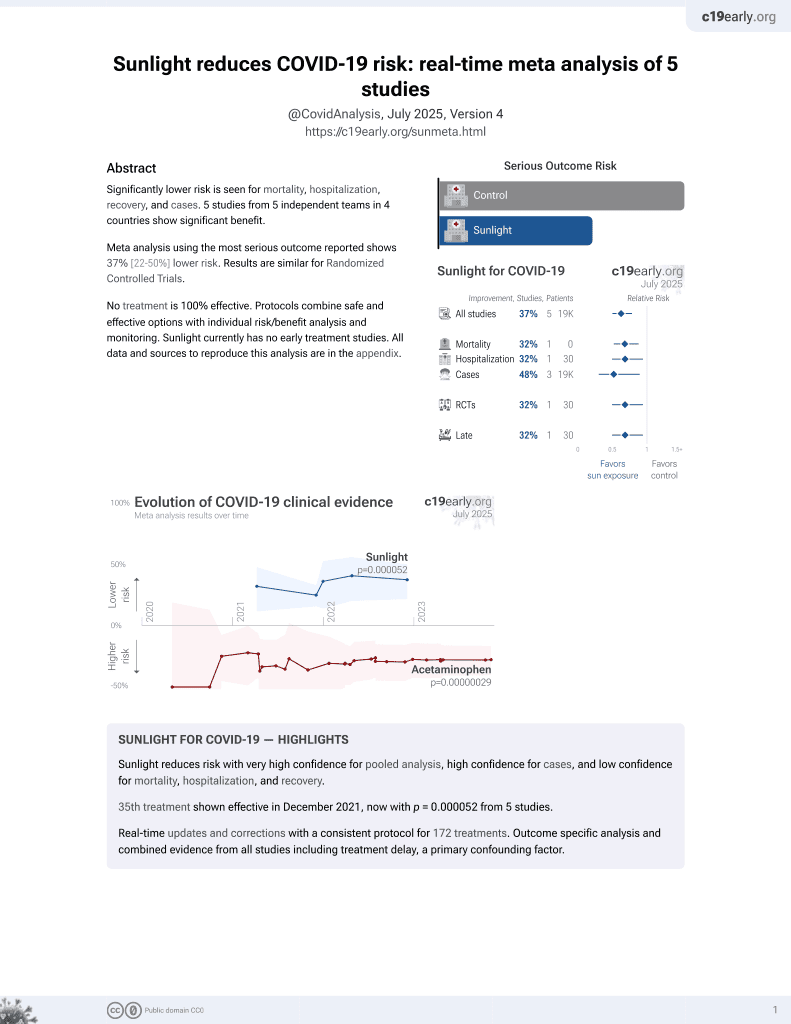
Seasonality and uncertainty in global COVID-19 growth rates
et al., Proceedings of the National Academy of Sciences, doi:10.1073/pnas.2008590117, Oct 2020
Sunlight for COVID-19
35th treatment shown to reduce risk in
December 2021, now with p = 0.000052 from 5 studies.
No treatment is 100% effective. Protocols
combine treatments.
6,300+ studies for
210+ treatments. c19early.org
|
Global analysis of COVID-19 cases and weather, showing increased UV light associated with a lower COVID-19 growth rate.
Merow et al., 13 Oct 2020, peer-reviewed, 2 authors.
Abstract: Seasonality and uncertainty in global COVID-19
growth rates
Cory Merowa,b,c,1 and Mark C. Urbanb,c
a
Eversource Energy Center, University of Connecticut, Storrs, CT 06268; bCenter of Biological Risk, University of Connecticut, Storrs, CT 06268;
and cDepartment of Ecology & Evolutionary Biology, University of Connecticut, Storrs, CT 06268
Edited by Nils Chr. Stenseth, University of Oslo, Oslo, Norway, and approved September 16, 2020 (received for review May 1, 2020)
The virus causing COVID-19 has spread rapidly worldwide and
threatens millions of lives. It remains unknown, as of April 2020,
whether summer weather will reduce its spread, thereby alleviating strains on hospitals and providing time for vaccine development. Early insights from laboratory studies and research on
related viruses predicted that COVID-19 would decline with higher
temperatures, humidity, and ultraviolet (UV) light. Using current,
fine-scaled weather data and global reports of infections, we develop a model that explains 36% of the variation in maximum
COVID-19 growth rates based on weather and demography
(17%) and country-specific effects (19%). UV light is most strongly
associated with lower COVID-19 growth. Projections suggest that,
without intervention, COVID-19 will decrease temporarily during
summer, rebound by autumn, and peak next winter. Validation
based on data from May and June 2020 confirms the generality
of the climate signal detected. However, uncertainty remains high,
and the probability of weekly doubling rates remains >20%
throughout summer in the absence of social interventions. Consequently, aggressive interventions will likely be needed despite
seasonal trends.
SARS-CoV-2
| climate | pandemic | UV light | humidity
C
OVID-19 is causing widespread morbidity and mortality
globally (1, 2). The severe acute respiratory syndrome coronavirus 2 (SARS-CoV-2) responsible for this disease infected
more than 17 million people by August 2020 (3). Much of the
world has implemented nonpharmaceutical interventions, including preventing large gatherings, voluntary or enforced social distancing, and contact tracing and quarantining, in order to prevent
infections from overwhelming health care systems and exacerbating mortality rates (2, 4). However, these interventions risk
substantial economic damage, and thus decision makers are currently developing or implementing plans for lifting these restrictions. Consequently, improved forecasts of COVID-19 risks are
needed to inform decisions that weigh the risks to both human
health and economy (2).
One of the greatest uncertainties for projecting future COVID19 risk is how weather will affect its future transmission dynamics.
SARS-CoV-2 might be particularly sensitive to weather, because
preliminary laboratory trials suggest that it survives longer outside
the human body than other viruses (5). Rising temperatures and
humidity in the Northern Hemisphere summer could reduce
SARS-CoV-2 transmission rates (6–8), providing a temporary
reprieve. Simultaneously, the Southern Hemisphere has entered
winter, and we do not know whether winter weather will increase
COVID-19 risks, especially in countries with reduced health care
capacity. Early analyses of COVID-19 cases predicted that high
temperatures would reduce summer transmission (9–11). These
predictions have been widely reported and are informing decisions
about..
DOI record:
{
"DOI": "10.1073/pnas.2008590117",
"ISSN": [
"0027-8424",
"1091-6490"
],
"URL": "http://dx.doi.org/10.1073/pnas.2008590117",
"abstract": "<jats:title>Significance</jats:title>\n <jats:p>The virus causing COVID-19 has spread rapidly worldwide. It remains unknown whether summer weather will reduce its spread and justify relaxing political interventions and restarting economic activities. We develop statistical models that predict the maximum potential of COVID-19 worldwide and throughout the year. We find that UV light, in particular, is associated with decreased disease growth rate relative to other analyzed factors. Based on these associations with weather, we predict that COVID-19 will decrease temporarily during summer, rebound by autumn, and peak next winter. However, uncertainty remains high, and many factors besides climate, such as social interventions, will influence transmission. Thus, the world must remain vigilant, and continued interventions will likely be needed until a vaccine becomes available.</jats:p>",
"alternative-id": [
"10.1073/pnas.2008590117"
],
"assertion": [
{
"group": {
"label": "Publication History",
"name": "publication_history"
},
"label": "Published",
"name": "published",
"order": 2,
"value": "2020-10-13"
}
],
"author": [
{
"affiliation": [
{
"name": "Eversource Energy Center, University of Connecticut, Storrs, CT 06268;"
},
{
"name": "Center of Biological Risk, University of Connecticut, Storrs, CT 06268;"
},
{
"name": "Department of Ecology & Evolutionary Biology, University of Connecticut, Storrs, CT 06268"
}
],
"family": "Merow",
"given": "Cory",
"sequence": "first"
},
{
"ORCID": "http://orcid.org/0000-0003-3962-4091",
"affiliation": [
{
"name": "Center of Biological Risk, University of Connecticut, Storrs, CT 06268;"
},
{
"name": "Department of Ecology & Evolutionary Biology, University of Connecticut, Storrs, CT 06268"
}
],
"authenticated-orcid": false,
"family": "Urban",
"given": "Mark C.",
"sequence": "additional"
}
],
"container-title": "Proceedings of the National Academy of Sciences",
"container-title-short": "Proc. Natl. Acad. Sci. U.S.A.",
"content-domain": {
"crossmark-restriction": true,
"domain": [
"www.pnas.org"
]
},
"created": {
"date-parts": [
[
2020,
10,
13
]
],
"date-time": "2020-10-13T21:11:15Z",
"timestamp": 1602623475000
},
"deposited": {
"date-parts": [
[
2022,
4,
13
]
],
"date-time": "2022-04-13T11:26:17Z",
"timestamp": 1649849177000
},
"funder": [
{
"DOI": "10.13039/100000001",
"award": [
"HDR-1394790"
],
"doi-asserted-by": "publisher",
"name": "National Science Foundation"
},
{
"DOI": "10.13039/100000001",
"award": [
"DEB-1555876"
],
"doi-asserted-by": "publisher",
"name": "National Science Foundation"
}
],
"indexed": {
"date-parts": [
[
2023,
6,
1
]
],
"date-time": "2023-06-01T01:35:13Z",
"timestamp": 1685583313109
},
"is-referenced-by-count": 157,
"issue": "44",
"issued": {
"date-parts": [
[
2020,
10,
13
]
]
},
"journal-issue": {
"issue": "44",
"published-print": {
"date-parts": [
[
2020,
11,
3
]
]
}
},
"language": "en",
"license": [
{
"URL": "https://creativecommons.org/licenses/by/4.0/",
"content-version": "vor",
"delay-in-days": 0,
"start": {
"date-parts": [
[
2020,
10,
13
]
],
"date-time": "2020-10-13T00:00:00Z",
"timestamp": 1602547200000
}
}
],
"link": [
{
"URL": "http://www.pnas.org/syndication/doi/10.1073/pnas.2008590117",
"content-type": "unspecified",
"content-version": "vor",
"intended-application": "syndication"
},
{
"URL": "https://pnas.org/doi/pdf/10.1073/pnas.2008590117",
"content-type": "unspecified",
"content-version": "vor",
"intended-application": "similarity-checking"
}
],
"member": "341",
"original-title": [],
"page": "27456-27464",
"prefix": "10.1073",
"published": {
"date-parts": [
[
2020,
10,
13
]
]
},
"published-online": {
"date-parts": [
[
2020,
10,
13
]
]
},
"published-print": {
"date-parts": [
[
2020,
11,
3
]
]
},
"publisher": "Proceedings of the National Academy of Sciences",
"reference": [
{
"key": "e_1_3_5_1_2",
"unstructured": "World Health Organization “Coronavirus disease 2019 (COVID-19)” (Situation Rep. 67 World Health Organization 2020)."
},
{
"DOI": "10.1101/2020.04.02.20050773",
"doi-asserted-by": "crossref",
"key": "e_1_3_5_2_2",
"unstructured": "M. T. P. Coelho . Exponential phase of covid19 expansion is not driven by climate at global scale. medRxiv:10.1101/2020.04.02.20050773 (6 May 2020)."
},
{
"DOI": "10.1016/S1473-3099(20)30120-1",
"doi-asserted-by": "publisher",
"key": "e_1_3_5_3_2"
},
{
"key": "e_1_3_5_4_2",
"unstructured": "N. Ferguson . “Impact of non-pharmaceutical interventions (NPIs) to reduce COVID19 mortality and healthcare demand” (Rep. 9 Imperial College London 2020)."
},
{
"key": "e_1_3_5_5_2",
"unstructured": "National Academies of Sciences “Medicine rapid expert consultation on SARS-CoV-2 survival in relation to temperature and humidity and potential for seasonality for the COVID-19 pandemic (April 7 2020)” (Report The National Academies Press Washington DC 2020)."
},
{
"DOI": "10.1038/s41598-018-37481-y",
"doi-asserted-by": "publisher",
"key": "e_1_3_5_6_2"
},
{
"DOI": "10.1371/journal.ppat.1007327",
"doi-asserted-by": "publisher",
"key": "e_1_3_5_7_2"
},
{
"DOI": "10.1136/jech.2004.020180",
"doi-asserted-by": "publisher",
"key": "e_1_3_5_8_2"
},
{
"DOI": "10.2139/ssrn.3551767",
"doi-asserted-by": "crossref",
"key": "e_1_3_5_9_2",
"unstructured": "J. Wang K. Tang K. Feng W. Lv High temperature and high humidity reduce the transmission of COVID-19. SSRN:10.2139/ssrn.3551767 (9 March 2020)."
},
{
"DOI": "10.2139/ssrn.3550308",
"doi-asserted-by": "crossref",
"key": "e_1_3_5_10_2",
"unstructured": "M. M. Sajadi . Temperature and latitude analysis to predict potential spread and seasonality for covid-19. SSRN:10.2139/ssrn.3550308 (9 March 2020)."
},
{
"DOI": "10.1101/2020.03.12.20034728",
"doi-asserted-by": "crossref",
"key": "e_1_3_5_11_2",
"unstructured": "M. B. Araujo B. Naimi Spread of SARS-CoV-2 coronavirus likely to be constrained by climate. medRxiv:10.1101/2020.03.12.20034728 (7 April 2020)."
},
{
"DOI": "10.1016/S2666-5247(20)30095-1",
"doi-asserted-by": "crossref",
"key": "e_1_3_5_12_2",
"unstructured": "A. Chin . Stability of SARS-CoV-2 in different environmental conditions.medRxiv:10.1101/2020.03.15.20036673 (27 March 2020)."
},
{
"DOI": "10.1155/2011/734690",
"doi-asserted-by": "publisher",
"key": "e_1_3_5_13_2"
},
{
"DOI": "10.1016/j.ajic.2005.12.006",
"doi-asserted-by": "publisher",
"key": "e_1_3_5_14_2"
},
{
"DOI": "10.1186/s12985-017-0896-0",
"doi-asserted-by": "publisher",
"key": "e_1_3_5_15_2"
},
{
"DOI": "10.1371/journal.ppat.1003194",
"doi-asserted-by": "publisher",
"key": "e_1_3_5_16_2"
},
{
"DOI": "10.1186/s12889-016-3114-x",
"doi-asserted-by": "publisher",
"key": "e_1_3_5_17_2"
},
{
"DOI": "10.1093/aje/kwt132",
"doi-asserted-by": "publisher",
"key": "e_1_3_5_18_2"
},
{
"DOI": "10.3390/v11030207",
"doi-asserted-by": "publisher",
"key": "e_1_3_5_19_2"
},
{
"DOI": "10.1073/pnas.1902840116",
"doi-asserted-by": "publisher",
"key": "e_1_3_5_20_2"
},
{
"DOI": "10.1101/2020.04.03.20052787",
"doi-asserted-by": "crossref",
"key": "e_1_3_5_21_2",
"unstructured": "R. E. Baker W. Yang G. A. Vecchi C. J. E. Metcalf B. T. Grenfell Susceptible supply limits the role of climate in the COVID-19 pandemic. medRxiv:10.1101/2020.04.03.20052787 (7 April 2020)."
},
{
"DOI": "10.1073/pnas.0806852106",
"doi-asserted-by": "publisher",
"key": "e_1_3_5_22_2"
},
{
"DOI": "10.1371/journal.pbio.1000316",
"doi-asserted-by": "publisher",
"key": "e_1_3_5_23_2"
},
{
"DOI": "10.1128/JVI.79.22.14244-14252.2005",
"doi-asserted-by": "publisher",
"key": "e_1_3_5_24_2"
},
{
"DOI": "10.1016/j.jviromet.2004.06.006",
"doi-asserted-by": "publisher",
"key": "e_1_3_5_25_2"
},
{
"DOI": "10.3390/nu12040988",
"doi-asserted-by": "publisher",
"key": "e_1_3_5_26_2"
},
{
"DOI": "10.1056/NEJMoa2001316",
"doi-asserted-by": "publisher",
"key": "e_1_3_5_27_2"
},
{
"DOI": "10.1101/2020.04.24.20075838",
"doi-asserted-by": "crossref",
"key": "e_1_3_5_28_2",
"unstructured": "F. H. Lau . Vitamin D insufficiency is prevalent in severe COVID-19. medRxiv:10.1101/2020.04.24.20075838 (28 April 2020)."
},
{
"DOI": "10.1007/s40520-020-01570-8",
"doi-asserted-by": "publisher",
"key": "e_1_3_5_29_2"
},
{
"DOI": "10.1016/S2214-109X(20)30123-6",
"doi-asserted-by": "publisher",
"key": "e_1_3_5_30_2"
},
{
"DOI": "10.1126/science.abc2535",
"doi-asserted-by": "publisher",
"key": "e_1_3_5_31_2"
},
{
"DOI": "10.1073/pnas.1710231115",
"doi-asserted-by": "publisher",
"key": "e_1_3_5_32_2"
},
{
"DOI": "10.1126/science.aad8466",
"doi-asserted-by": "publisher",
"key": "e_1_3_5_33_2"
},
{
"DOI": "10.1093/aje/kws259",
"doi-asserted-by": "publisher",
"key": "e_1_3_5_34_2"
},
{
"author": "U.S. National Academy of Sciences",
"key": "e_1_3_5_35_2",
"unstructured": "U.S. National Academy of Sciences, Understanding Climatic Change: A Program for Action, (National Academy of Sciences, Washington, DC, 1975).",
"volume-title": "Understanding Climatic Change: A Program for Action",
"year": "1975"
},
{
"key": "e_1_3_5_36_2",
"unstructured": "Copernicus Climate Change Service ERA5: Fifth generation of ECMWF atmospheric reanalyses of the global climate (Copernicus Climate Change Service 2018)."
},
{
"DOI": "10.1002/joc.5086",
"doi-asserted-by": "publisher",
"key": "e_1_3_5_37_2"
},
{
"DOI": "10.32942/osf.io/mr6pn",
"doi-asserted-by": "crossref",
"key": "e_1_3_5_38_2",
"unstructured": "J. D. Chipperfield B. M. Benito R. B. O’Hara R. J. Telford C. J. Carlson On the inadequacy of species distribution models for modelling the spread of SARS-CoV-2: Response to Araújo and Naimi EcoEvoRxiv:10.32942/osf.io/mr6pn (28 March 2020)."
},
{
"key": "e_1_3_5_39_2",
"unstructured": "B. Goodrich J. Gabry I. Ali S. Brilleman rstanarm: Bayesian applied regression modeling via Stan. R package version 2.19.3. https://cds.climate.copernicus.eu/cdsapp#!/dataset/reanalysis-era5-single-levels?tab=form. Accessed 13 April 2020."
},
{
"article-title": "The number of iterations, convergence diagnostics and generic Metropolis algorithms",
"author": "Raftery A. E.",
"first-page": "763",
"journal-title": "Practical Markov Chain Monte Carlo",
"key": "e_1_3_5_40_2",
"unstructured": "A. E. Raftery, S. M. Lewis, The number of iterations, convergence diagnostics and generic Metropolis algorithms. Practical Markov Chain Monte Carlo 7, 763–773 (1995).",
"volume": "7",
"year": "1995"
},
{
"DOI": "10.1101/2020.03.16.20037168",
"doi-asserted-by": "crossref",
"key": "e_1_3_5_41_2",
"unstructured": "B. Chen . Roles of meteorological conditions in COVID-19 transmission on a worldwide scale. medRxiv:10.1101/2020.03.16.20037168 (20 March 2020)."
},
{
"DOI": "10.1007/s11222-016-9696-4",
"doi-asserted-by": "publisher",
"key": "e_1_3_5_42_2"
},
{
"DOI": "10.1111/gcb.13251",
"doi-asserted-by": "publisher",
"key": "e_1_3_5_43_2"
},
{
"DOI": "10.1111/ele.12443",
"doi-asserted-by": "publisher",
"key": "e_1_3_5_44_2"
}
],
"reference-count": 44,
"references-count": 44,
"relation": {},
"resource": {
"primary": {
"URL": "https://pnas.org/doi/full/10.1073/pnas.2008590117"
}
},
"score": 1,
"short-title": [],
"source": "Crossref",
"subject": [
"Multidisciplinary"
],
"subtitle": [],
"title": "Seasonality and uncertainty in global COVID-19 growth rates",
"type": "journal-article",
"update-policy": "http://dx.doi.org/10.1073/pnas.cm10313",
"volume": "117"
}
